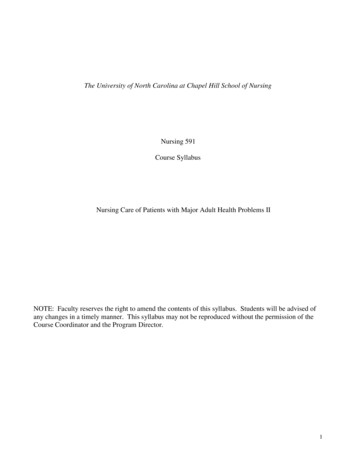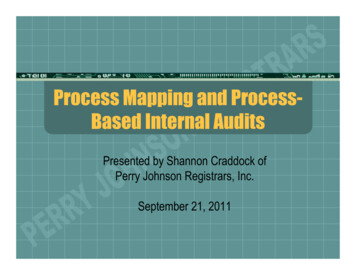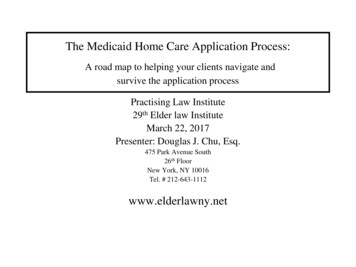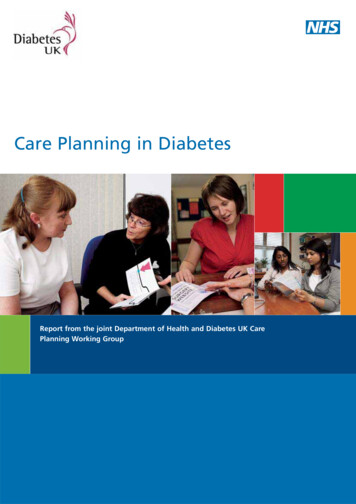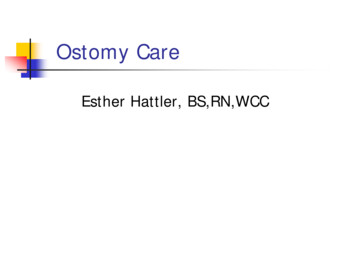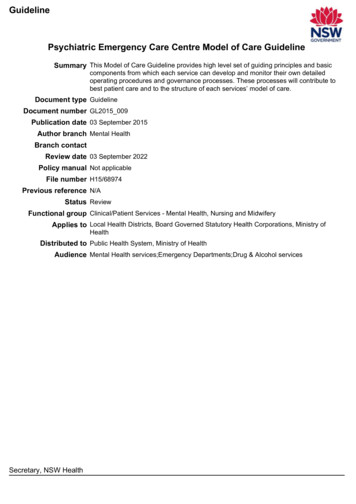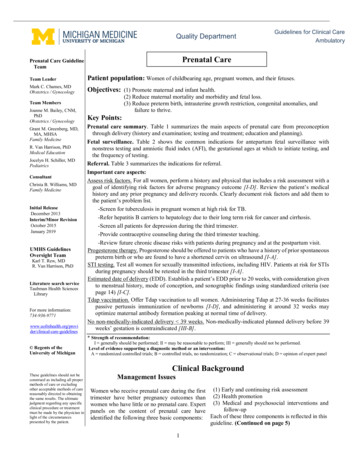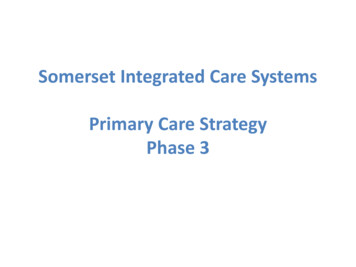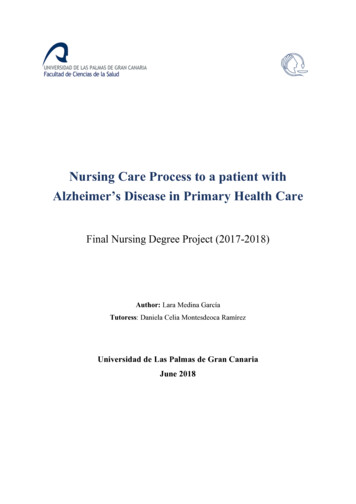
Transcription
Nursing Care Process to a patient withAlzheimer’s Disease in Primary Health CareFinal Nursing Degree Project (2017-2018)Author: Lara Medina GarcíaTutoress: Daniela Celia Montesdeoca RamírezUniversidad de Las Palmas de Gran CanariaJune 2018
ABSTRACTAlzheimer’s disease is the most common form of dementia, being one of the main causes ofdisability and dependency among the elderly worldwide, so an adequate approach to it mightmean an increase of the quality of life both the patient and their caregivers.In this project, we present a Nursing Care Plan to a dependent patient with Alzheimer's diseasein Primary Health Care ambit. In the follow-up of dementias, we must bear in mind theobstacles we can find are behavioral alterations, among others, that lead to greater fragility inthese patients.A comprehensive assessment has been carried out through the 11 functional patterns of MarjoryGordon, where the problems with the patient’s health- patient's process, the antecedents inDorothea Orem's theory of self-care, and the use of the three Languages recognized by theAmerican Nurses Association (ANA): the American Association of Nursing Diagnosis(NANDA), the Classification of Nursing Outcomes (NOC) and the Classification of NursingInterventions (NIC).A comprehensive assessment has been carried out through the 11 functional patterns of MarjoryGordon, where the problems with the health process, the patient's illness, the antecedents inDorothea Orem's theory of self-care and the use of the three languages, recognized by theAmerican Nurses Association (ANA): the American Association of Nursing Diagnosis(NANDA), the Classification of Nursing Outcomes (NOC) and the Classification of NursingInterventions (NIC).The intervention focuses on the analysis of nursing diagnoses, nutritional imbalance, insomnia,memory impairment and anxiety.After implementing the activities, we have assessed with the Likert scale certain characteristicsand indicators of the patient to verify how the identified diagnoses have evolved.Finally, it should be emphasised that the Care Plan has been carried out satisfactorily,prioritizing the patient's problems and acting on them with the collaboration of the a,aging,primarymultidisciplinary work, care plan, intervention, caregiver, nursing.care,dependence,
1. INTRODUCTIONThere is currently an unprecedented demographic change confirmed by the World HealthOrganization (WHO) in its latest "World Report on Aging and Health"1, which provides dataon this process called population aging, caused mainly by an increase in life expectancy andthe reduction of the birth rate, accompanied by a great socioeconomic development. Accordingto data from the National Institute of Statistics (INE) as of January 1, 2016, there are 8,657,705elderly people in our country (65 and over), corresponding to 18.4% of the total population2.During aging, changes occur in this process that lead these people to suffer greater vulnerabilitywhen it comes to suffering from chronic diseases (CD), multiple pathologies and fragility3, aswell as an increase in the incidence of the disease that we will deal with in this project,Alzheimer's disease (AD).According to WHO, dementia is a syndrome, usually of a chronic or progressive nature,characterized by the deterioration of cognitive function (in other words, the ability to processthought) beyond what could be considered a consequence of aging normal. The deteriorationof cognitive function is often accompanied, and sometimes is preceded by the deterioration ofemotional control, social behavior or motivation. Dementia is one of the leading causes ofdisability and dependency among the elderly worldwide. The forms, or causes, of dementia aremultiple and diverse. AD is the most common form of dementia: it is estimated that it representsbetween 60% and 70% of cases4-5, and the incidence of it increases exponentially with age (1625% in the elderly 85 years old)6, so we can predict an epidemic worldwide in the comingdecades7, observing a more aged population with worse health8.Worldwide, the International Alzheimer's Association (ADI) has issued reports on theprevalence of this pathology, observing a total of approximately 46.8 million cases9-10. In Spainthe approximate cases of dementia in 2015 were 150,000 new cases, adding to the end, togetherwith the previous ones, a total of 600,000 cases. It should be emphasised that the trends predictthat dementia in our country will increase in the coming years, observing forecasts for the year2050 more than 1,500,000 cases of people with dementia, triple that currently9. Despite this, it3
is probable that these figures underestimate the real value of the problem, since a nonquantifiable proportion of cases are undiagnosed or not found in the official registers5-7.The INE has official mortality data of 2015, and we found that, when comparing diseases,"dementia" appears as the fourth disease with the most deaths in that year (20,442: 13,800women and 6,642 men), while the "Alzheimer's disease" is the seventh cause of death, with15,578 deaths (11,004 women and 4,574 men). If both were added, they would be the first causeof death, ahead of the "ischemic diseases of the heart" (33,769 deaths). Between 60-70% ofdeaths due to dementia occur in women7-8.From a general perspective, 80% of Alzheimer's patients are cared by their family. Dementia isthe CD that causes the greatest dependence, with 88.7% of all people in this situation, abovecerebrovascular accidents or Parkinson's disease, among others. It is convenient to add that itis one of the main causes of institutionalization, finding in Spain, annual rates of 10.5% in thisgroup7.The WHO has already warned about the different consequences of this fact and encouragesgovernments to take steps that reduce the social and health impact of this dire condition,carrying out projects at national level against Alzheimer's disease. It is estimated that the delayin the occurrence of AD in one year, through preventive interventions, would reduce about 12million of cases the number of patients worldwide by 20504,7.Being a neurodegenerative disease, progressive, irreversible and chronic, the care intended forpeople suffering from AD must be comprehensive and adapted to the variability during themorbid process, in a multidisciplinary way, taking into account the different dimensions of theaffected person: the cognitive, emotional, social, functional and, therefore, in the quality of boththe patient and the caregiver6,11.In the economic dimension, each patient with dementia generates three types of costs that aredistributed as follows: health, including health care, hospital stays and medications (represents20% of total costs); social services, which include formal caregivers, domiciliary services, daycenters and residences (globally accounts for 40% of the total) and finally, the so-called nextexpenses, which include the services of the main caregiver and which sometimes require lossof income (these informal costs represent the other 40% of the total)10. The researches and4
statistics presented during the year 2017 in the report of the Brain Foundation, carried out bythe Spanish Society of Neurology (SEN), "Social impact of Alzheimer's disease and otherdementias"7 calculates that the cost per Alzheimer patient amount is between 27,000 and 37,000euros per year, and the family members assume an average of 87% of the total cost. But wemust bear in mind that it has been calculated that the patient, with this condition, requires about70 hours of weekly care, leading to an overload and great impact on the family members andcaregivers (in which stress is present in more than 75%)7.Regarding the role of the nursing professional in relation to AD, its labor is essential in theassessment of the patient's condition, in terms of the deterioration suffered by people affectedby this pathology, in a comprehensive manner and adapted to the patient's own needs. Findingthe guidance and health education that must be provided in order to improve quality care andreduce the risk factors in the social and economic situation, promoting family cohesion and thedevelopment of appropriate interpersonal relationships8,11.Therefore, the improvement of information and education about dementias to the population,and especially the AD, is transformed from a simple activity to a priority task, sensitizing thedifferent health professionals of the improvements that lead the prevention of this disease andearly diagnosis. Likewise, the provision of training to professionals to achieve advances in thescreening of dementias and subsequent diagnoses, as well as the treatment of them that directlyinfluences the increase in the quality of care6,12. On the other hand, in the different nursing careplans to patients with AD, we can detect the multiple obstacles that can be found both patientsand their caregivers and family members regarding the adherence of the prescribed treatmentand the influence of the pathology on their well-being and quality of life, presenting behavioralterations, being able to express fear and anxiety, as well as sleep disorders13-15.The general aim is to design an Individualized Nursing Care Plan for a patient with AD in thePrimary Care (PC) field. The specific objectives are:o To detect, through a complete and integral assessment, the dysfunctional patterns thatappear during the realization of the care plan.o To identify and formulate the existing nursing diagnoses and the specific care needs to thepatient for each of the patterns altered according to the NANDA taxonomy.5
o To prioritize and plan with the patient and her main caregiver, some objectives and aprogram of activities to get these altered patterns back to normal as soon as possible, byusing the NOC and NIC taxonomies.o To execute the planned activities and evaluate the result of the nursing interventions.o To defend the importance of the nurse role in the prevention and approach of frailty inelderly people living in the community through home visits.2. METHODSeveral methodological resources have been used for the elaboration of this project. On onehand, for the development of the theoretical framework, a bibliographic search has been carriedout in the current databases such as Pubmed, Cochrane Plus, Cuiden, Dialnet and Scielo. Thekeywords which were used to build the search strategy according to the terminology of theDescriptors of Health Sciences (DeCS) and Medical Subjects Headings (MeSH) "Alzheimerdisease", "dementia", "aging", "primary health care", "dependency", "multidisciplinary team","care plan", "intervention", "caregivers" and "nursing".In this project, it is schedule an assessment and follow-up of a patient with Alzheimer's disease.The procedure that has been used to carry out this project has been the Nursing Care Process(NCP)16, which is an organized and systematic method of administering individualized nursingcare. It consists of five phases: assessment, diagnosis, planning, execution and evaluation. Inthe assessment stage the health status is determined, and the real and potential problems areidentified. The functional patterns of Marjory Gordon16 have been used as an assessment toolby an interview or anamnesis, and thus, to be able to identify the altered patterns.We have also based on the model of Dorothea Orem17, a nurse who motivated and promotedthe Theory of Self-care. In this theory, Orem details that self-care is about ". a behavior ofmature and maturing people who have learned and developed the skills to take care ofthemselves in their environmental situations". Nursing professionals in the practice of thismodel determine what requirements are demanded by the patient, distinguish appropriate waysto cover them and the proper course of action and determine the patient's abilities to satisfytheir needs.6
On the other hand, the North American Nursing Diagnosis Association (NANDA)18 taxonomywas applied to formulate the nursing diagnoses detected in the assessment and related to thepatient's disease process, attending to their association and application in the home context. Theproblems formulated have been prioritized, having to state the expected objectives based on theClassification of Nursing Outcomes (NOC)19 and, starting from this, formulate the mostrelevant interventions using the Classification of Nursing Interventions (NIC)20. Finally, bothwere used both for evaluation of results in the first assessment and to evaluate the progress ofthe patient.Specific scales were used in certain patterns for an assessment and continuous evaluation ofthem. For the assessment of the number one pattern of perception and health control, theFageström21 Test, the Richmond21 motivation questionnaire and the Morisky - Green –Leveen21 test were used. In the second nutritional-metabolic pattern, the adherencequestionnaire to the Mediterranean21 diet and the mini nutritional assessment (NMA) wereused. On the other hand, using the Katz21 index, the Barthel index21 and the Lawton and Brody21scale to assess the forth pattern of activity and exercise. Finally, the Goldberg test of anxietyand depression21 for the seventh pattern of self-control and self-concept, and the ApgarFamiliar21 test to assess the eight pattern of role and relationships.In the evaluation phase, the Likert22 scale, a structured instrument for data collection, was usedthrough a set of items that have a score between 1 (inadequate) and 5 (completely adequate).The scale shows the range in which the patient is at the time of assessment, the objective setand the result obtained after the nurses' activities.In addition, the Code of Ethics of Spanish Nursing23 current in our country, both in its prologueand in Article 17 specifies the ethical principles essential for an adequate development of thenursing professionals’ research activity.For this intervention, authoriza
"care plan", "intervention", "caregivers" and "nursing". In this project, it is schedule an assessment and follow-up of a patient with Alzheimer's disease. The procedure that has been used to carry out this project has been the Nursing Care Process (NCP)16, which is an organized and systematic method of administering individualized nursing care. It consists of five phases: assessment, diagnosis, planning,
